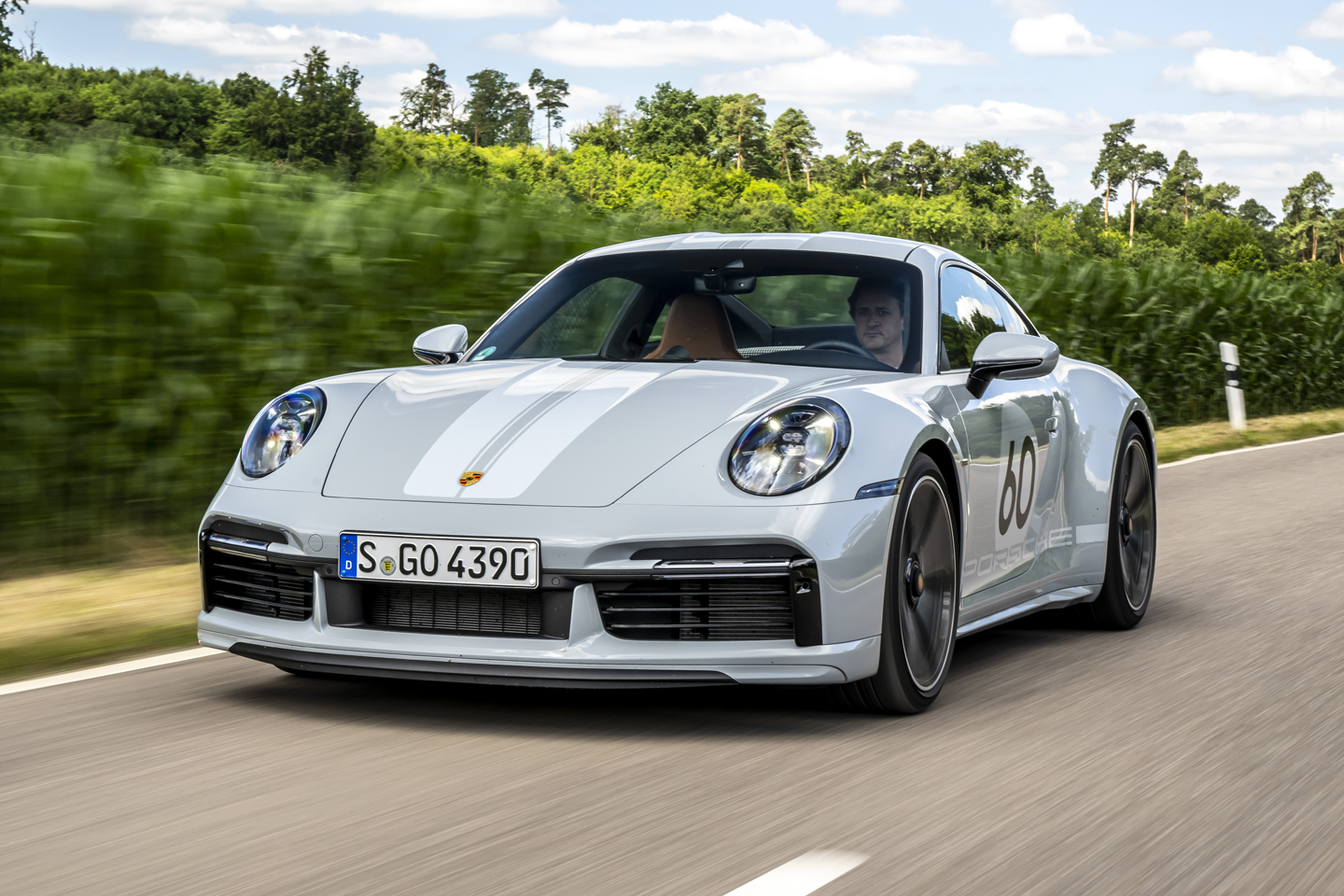
It’s not long since I was in Stuttgart, driving a colony of classic Porsche 911 Carrera RSs – I don’t know the collective noun for Carrera RSs; I am going with colony for the mild alliteration. Now, that trip centred on the 50th anniversary of the RS and its ducktail, so I feel particularly fortunate to be back in Zuffenhausen, just a couple of months later, driving the latest in the ducktail dynasty. After all, this swoop is as synonymous with tasty 911s as Nike’s swoosh is with its sneakers, so it has to be something special. And it is. It’s the latest Porsche 911 Sport Classic.
Firstly, it looks fabulous in the flesh. Not overdone. Not too in your face. Just the classic 911 teardrop with a ski-slope engine lid, and fat turbo arches covering elegant, five-spoke Fuchs-style wheels. Plus some gold detailing and hand-painted stripes to jazz it up. It’s not ‘too jazzy,’ though, to quote a line from The Inbetweeners. Just a welcome bit of glitter. I’d probably do without the roundels and big numbers on the doors, but looks wise, I can’t think of a lot else I’d change.
The cabin gets the thumbs up, too. I’ve said many times that I’ve grown really fond of the 992’s air-cooled-911-style interior overtures, in the design of its dash and dial arrangements. For the Sport Classic the retro theme is dialled up to eleven. There’s more gold in here, with the numbered Sport Classic badge on the dashboard. The number on it, by the way, will be between one and 1,250, because that’s how many Sport Classics will be built. Then there’s the pepita houndstooth cloth on the door panels and seat centres, which looks fabulous, and above your head a perforated Alcantara headlining that mimics those vinyl headlinings of yesteryear. There’s yet more nostalgia in the classic dayglo green lettering around the rev counter.

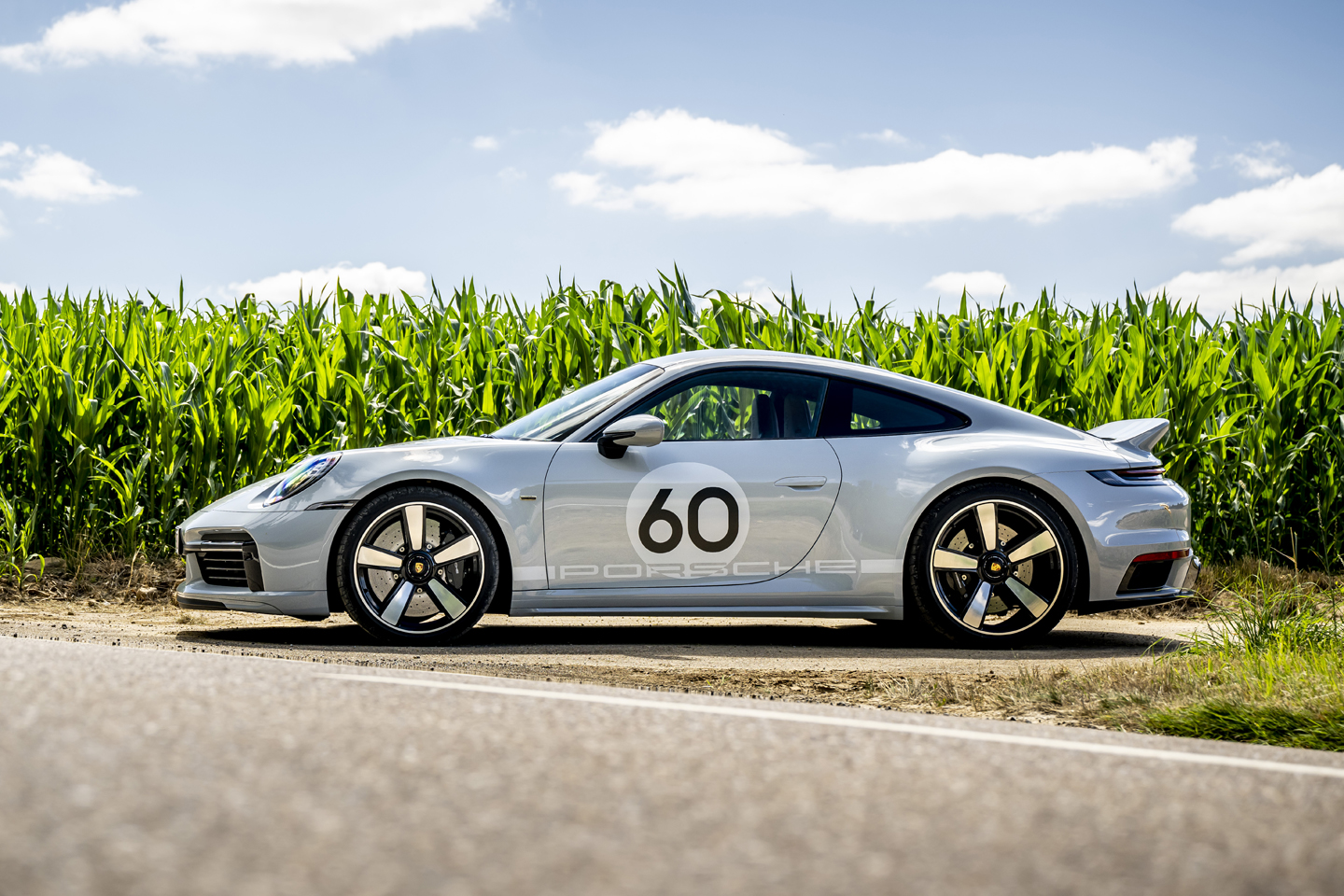
Some of those elements appear on many early Porsches – the green instruments are clear to see on the pretty 550 A Spyder, for example – and most appear on the oldest 911 in Porsche’s collection. That’s chassis number ’57, which is on display in its museum. And that’s the theme here: a car that echoes 60s and early 70s Porsches. So, if like me you’re a sentimental old duffer, you’ll probably find it jolly appealing.
Perhaps you’re not that way inclined. Maybe you’re reading this thinking it’s all a bit cynical. A Porsche Exclusive Manufaktur car harking back to the ‘glory days’ simply to squeeze a few more coffers out of the easily creamed super-rich. I mean, why not. Screw on a few bits of brass and sew in some strips of classic cloth on to what’s basically a 911 Turbo S, then ramp up the price to £215,000. And, if all of them were snapped up in an instant, as we were told, the policy’s a good’un.
Except that Porsche hasn’t simply patinaed it with the past. It could’ve done, and no doubt would’ve still sold the lot. But the engineers decided to do more than simply dip into the parts bin marked ‘Pastiche’ to make this Porsche special. There are a number of changes that make it an expensive car to produce for one destined to be made in such limited numbers. Some are skin deep, and some involve the skin itself. The changes are significant enough to demand the full gamut of series-production testing. The Sport Classic has been roasted at gas mark eleven in the heat of the desert; felt Jack Frost’s grip in the Arctic; plied on the miles on road; and, naturally, circumnavigated the Nordschleife many times as well.

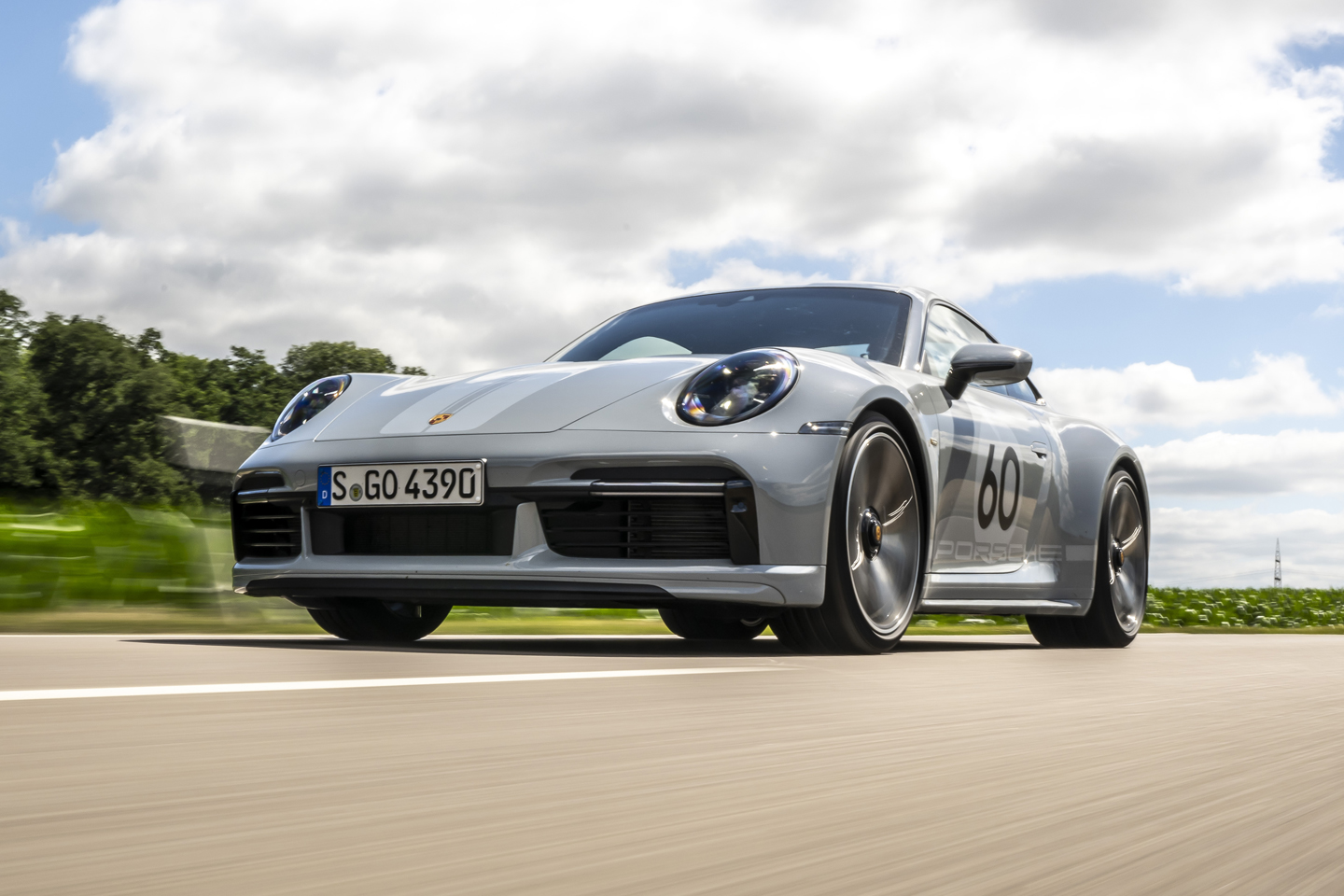
What are the bespoke bits? While it’s based on the Turbo S, you’ll notice that, for a start, there aren’t it any cooling holes in the rear wings. Technically, these aren’t needed on the Turbo S these days. Go back to the 997 and 991 Turbos and they were doing lots of cooling, but, on the 992, most of that’s achieved through vents at the rear. So they’re now more symbolic – a design signature that sets apart the capital ‘T’ Turbos from the tiny ‘t’ turbo Carreras. But they were deemed out of place here. Too modern. Like Big Ben with an LCD display.
Removing them was expensive. It meant new tooling to make the cleaner rear quarters, which start from the A-pillars back. And there was more outlay required to make the bonnet. The 992 GT3 has a ‘trough’ in the middle of its bonnet, like the one you see here, so they could’ve used that. The problem was it’s a different width to the bespoke double-bubble carbon roof on the Sport Classic. To match them they made a new bonnet, too – out of carbon fibre, naturally.
Then there’s the drivetrain. It has the Turbo S’s 3.7-litre flat-six and it’s been detuned. Now, if that sounds contrary to what you’re expecting from a special model, here’s the clincher: 550hp is absolutely all you need when it’s now thundering through just two oh-so-fat 315/30 21 Pirelli P Zeros at the rear. Yep, there’s no four-wheel drive here. And no PDK, either. This is the most powerful road-going manual 911 to date. And thanks to the removal of the front drive shafts, central prop shaft and the PDK gearbox, plus those lighter carbon bits, it’s lighter as well. Not by a massive amount, it has to be said, because there are luxury appointments that offset what’s gone. Still, at 1,570kg it’s 70kg lighter than the Turbo S, which is something.
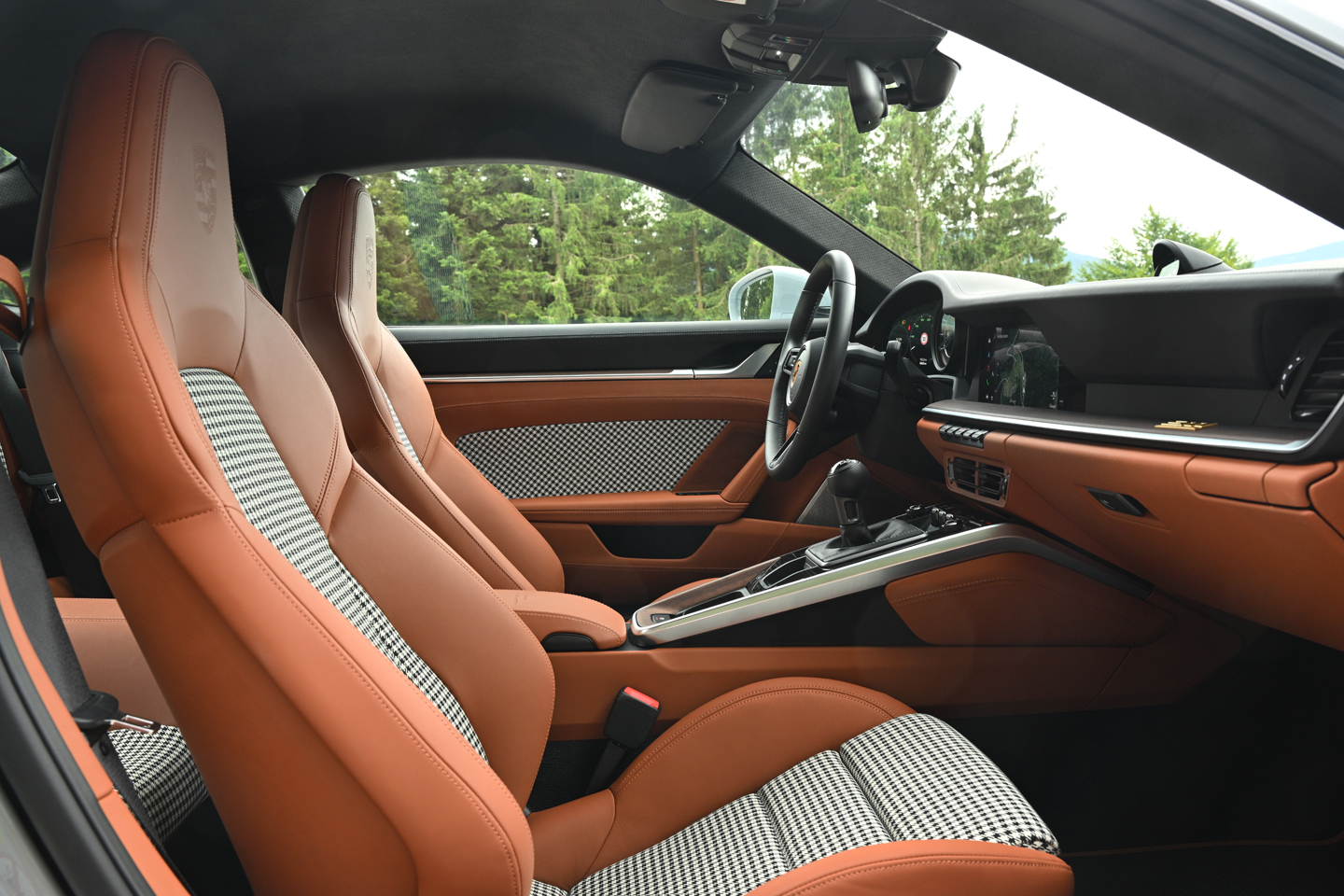
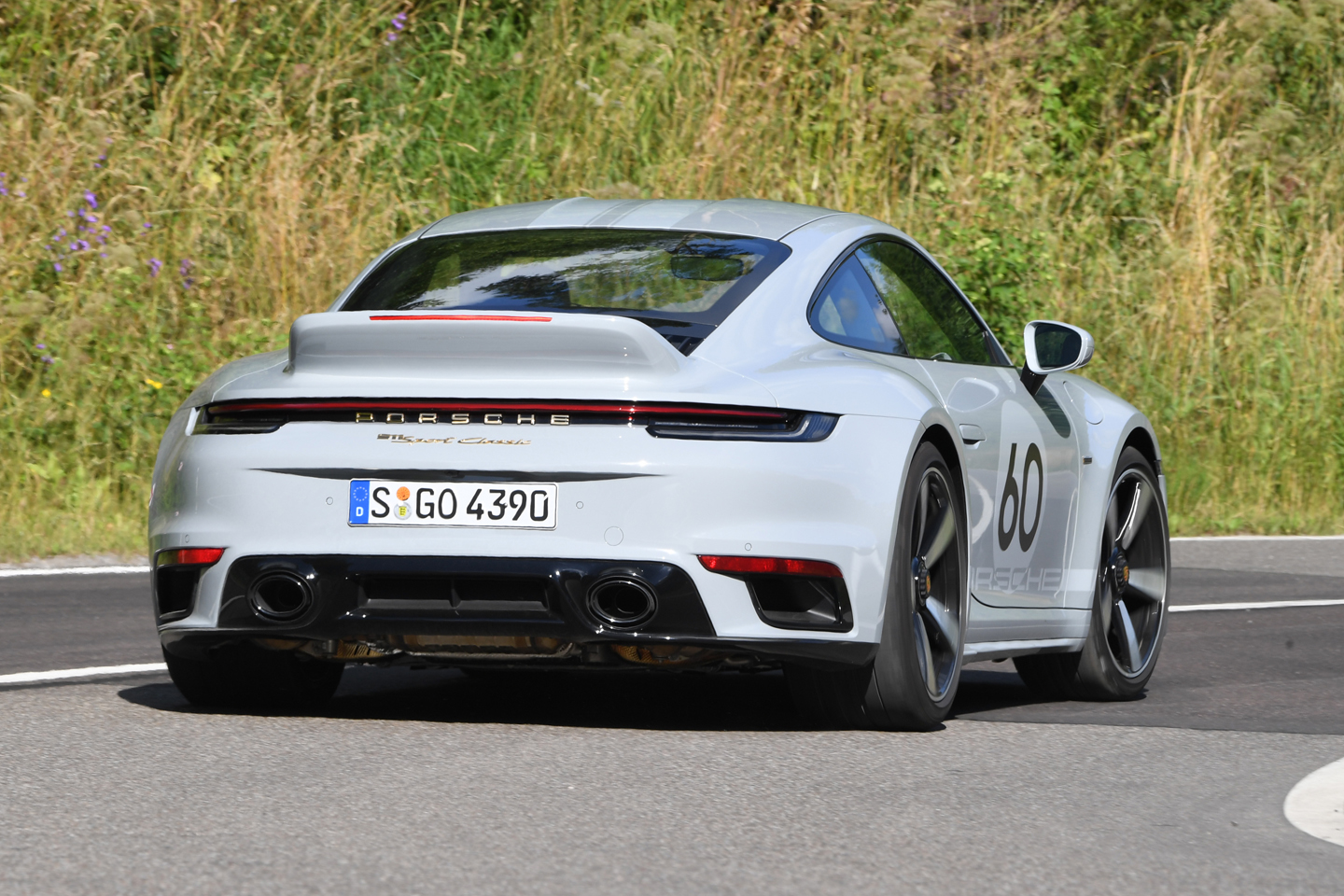
This isn’t a motorsport car, though. It’s a tourer, and we’re off touring. The heading is southwest, in the direction of the French and Swiss borders. Our destination is the rich, fertile land of Baden-Württemberg. The Black Forest. First, though, I’ve got to make it out of Stuttgart. The Sport Classic is waiting for me in a compound at Porsche Werk 4, just around the corner from the factory. As I walk up to it, it really does look the biz from the outside and, once I’m handed the keys and sitting behind the wheel, feels as rich inside as the gateau I will be enjoying in a few hours’ time.
I start the engine, and I’m struck by the sound. It’s crisper at low revs than the muted Turbo S. Those flat-six signatures come through clearer, more like the Carrera’s. That’ll be the retuned sports exhaust I read about somewhere in a press pack, then. It’s a sweet thing, listening to it rasping away out back as I make my way out of the city. And easy to drive in town as well. It doesn’t do histrionics. The clutch is manageable, and the gearchange deliberate but easygoing. The only thing I notice is some slight chunter through the body when the engine’s idling at red lights. I don’t mind that. It’s something connecting me to the mechanical elements underneath, which is a good thing.
As the confines of the city are consigned to the rear-view mirror, then fade away entirely, the road opens up. It’s my chance to explore the engine and a few more revs. Still it keeps reminding me of the Carrera’s 3.0-litre engine. So much so, I start wondering whether I’ve misread the brief. After all, the last Sport Classic, the 997, was based on the Carrera S, so maybe this one is, too? It sounds very much like the 3.0-litre in the low to mid-range, and now I’m revving it harder, under load, it’s generating the same hard-edged timbre as a 992 Carrera at the top end. And where are the huffs and hisses from the turbos? I’m sure I recall more of those from my last jaunt in a Turbo S? Here, the turbos are stealthier. Rather than the ahchoo of waste gates when I back off, there’s the baffled babble of unburnt fuel igniting in the exhaust. Is it dripping with character? Well, it’s miles away from, say, the gnashings of the GT3’s motor, but, for a modern, heavily boosted engine, it’s pretty good.
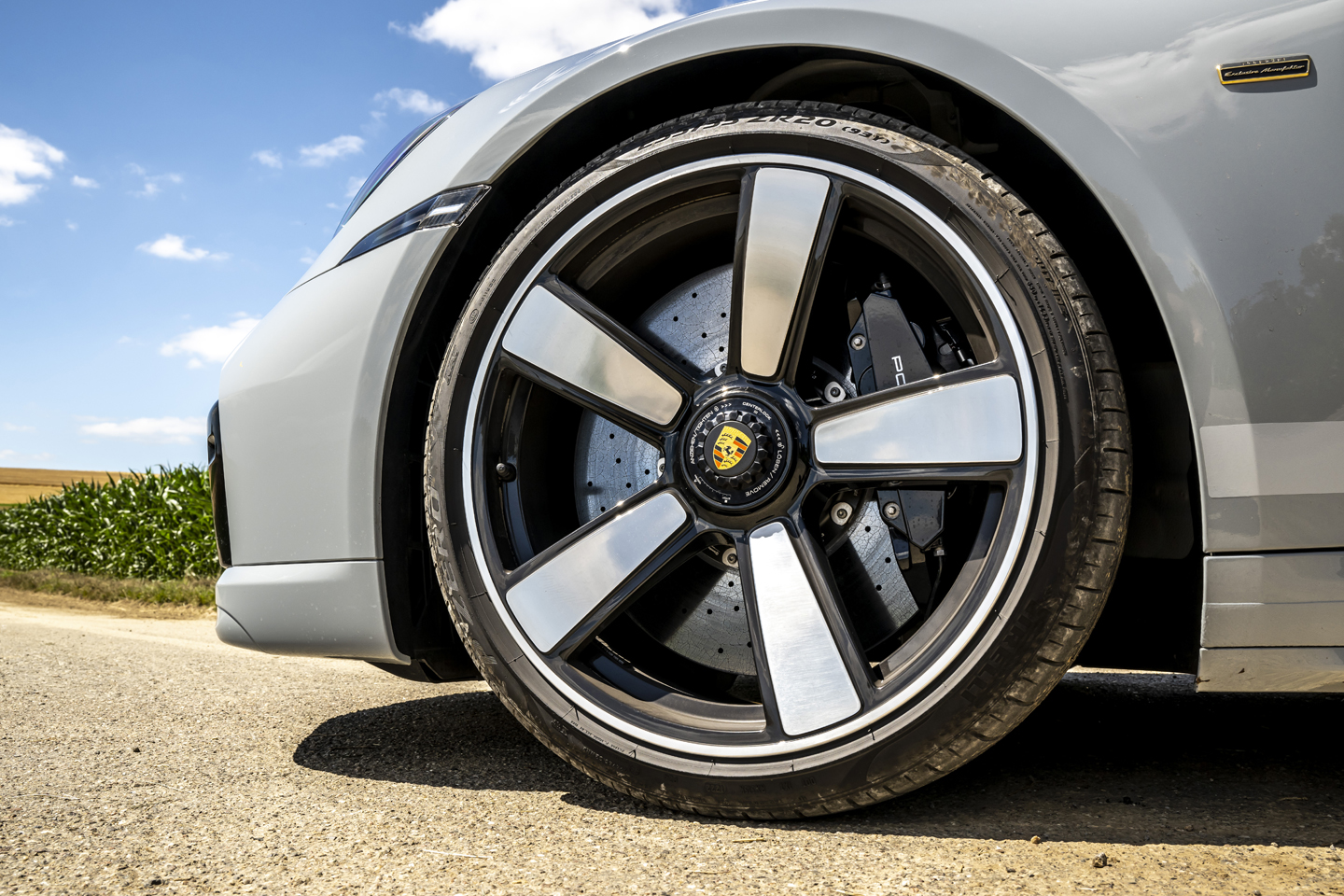
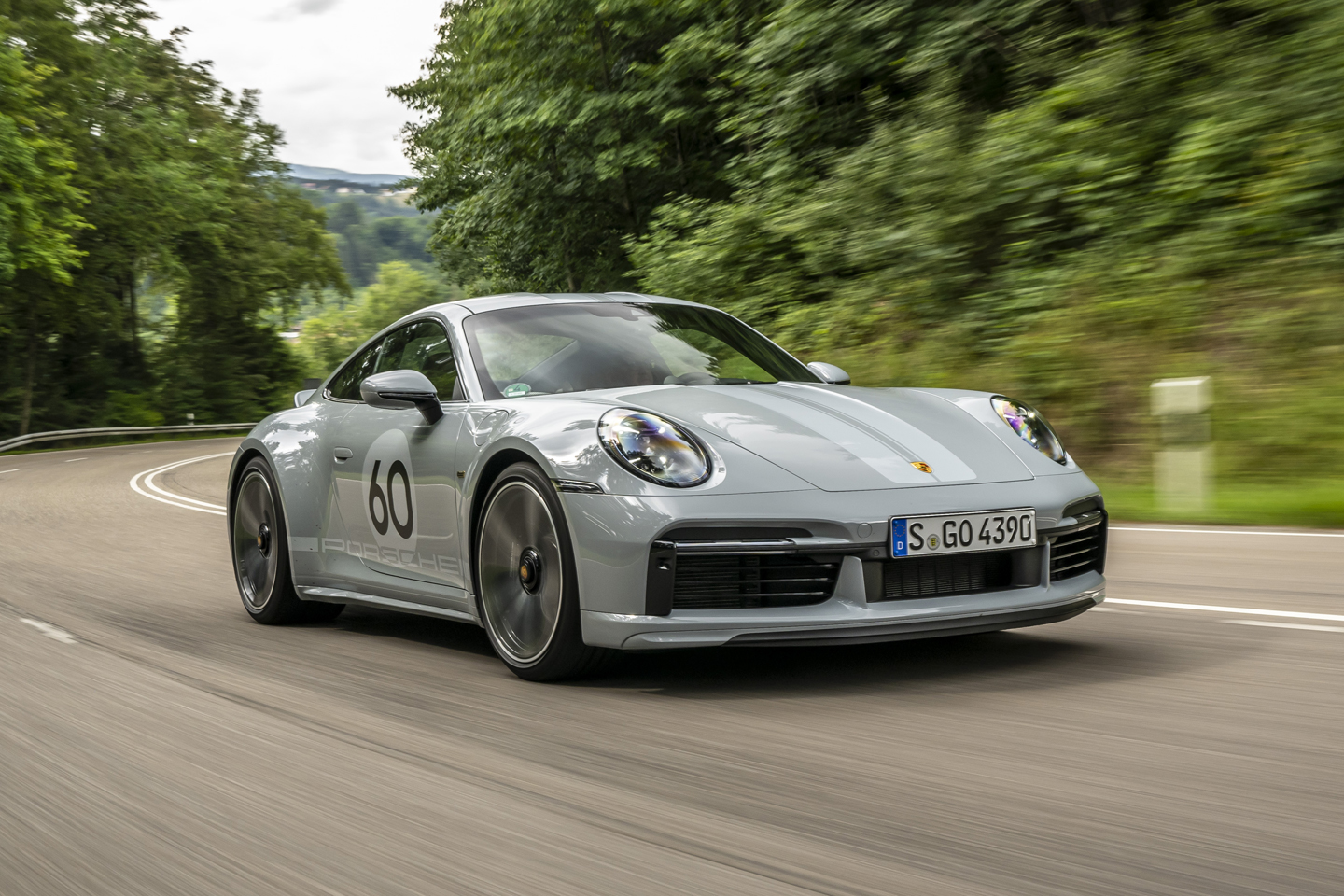
And speaking of heavily boosted, let’s talk about the power delivery. It turns out it’s not a 3.0-litre. Unleashed, the Sport Classic’s more fervent top end confirms that. There’s something retro here, too – as retro as the houndstooth – and it just about fits with the early 70s theme. The lag reminds me of the 930, which came out in 1975, and the days when turbos took an age to spool. When I put my foot down in a high gear there’s a wait, wait, wait…and then, when the ‘clock’ strikes 2,500rpm, bosh. The action begins. Suddenly, and with a right old kick. Any low-speed lethargy is blown away, quite literally, by the sudden awakening of forced induction and a savage attack of revs. The switch is so binary that it takes me a while to adjust. In first and second gear it’s headbutting the 7,200rpm limiter in a flash; the ‘bap, bap, bap’ of the ignition cutting in and out letting all and sundry know I’ve screwed the pooch.
Still, who cares. I’m driving a rear-wheel-drive Turbo with a proper manual gearbox. I’m the winner here. Especially as the seven-speed ’box’s change is still proving sweet, precise and, above all, more engaging than any Turbo with a PDK. Although it turns out you can’t rush it. I tried some quick cog swapping, geed up by the engine’s rapaciousness, and the synchromesh didn’t like it. Another pooch screwed and a few more strange looks. Eventually, though, the Sport Classic and I start to synch. I am remembering to be more considered with the gear changes and on my toes with the limiter.
It took a moment to adjust to the steering, too. It isn’t quick like a Ferrari’s, but I swear it’s quicker than any 911’s I’ve driven. It’s all the same hardware as the Turbo S, so it shouldn’t be. Maybe it’s my mind playing tricks with me again. Or perhaps it’s in the calibration of the revised rear-wheel steering, the altered spring rates and the retuned PASM. So much has been tweaked to counter the lighter nose and reduced overall mass, and the lower rotational inertia from ditching the front diff and driveshafts. But while the turn in seems unfamiliarly eager, the way it builds weight isn’t. That’s as intuitive as it is in any 911 and, while it’s not fizzing with feel like a GT3 with its hardwired bushing, there’s sensation channelling up the column all the same.
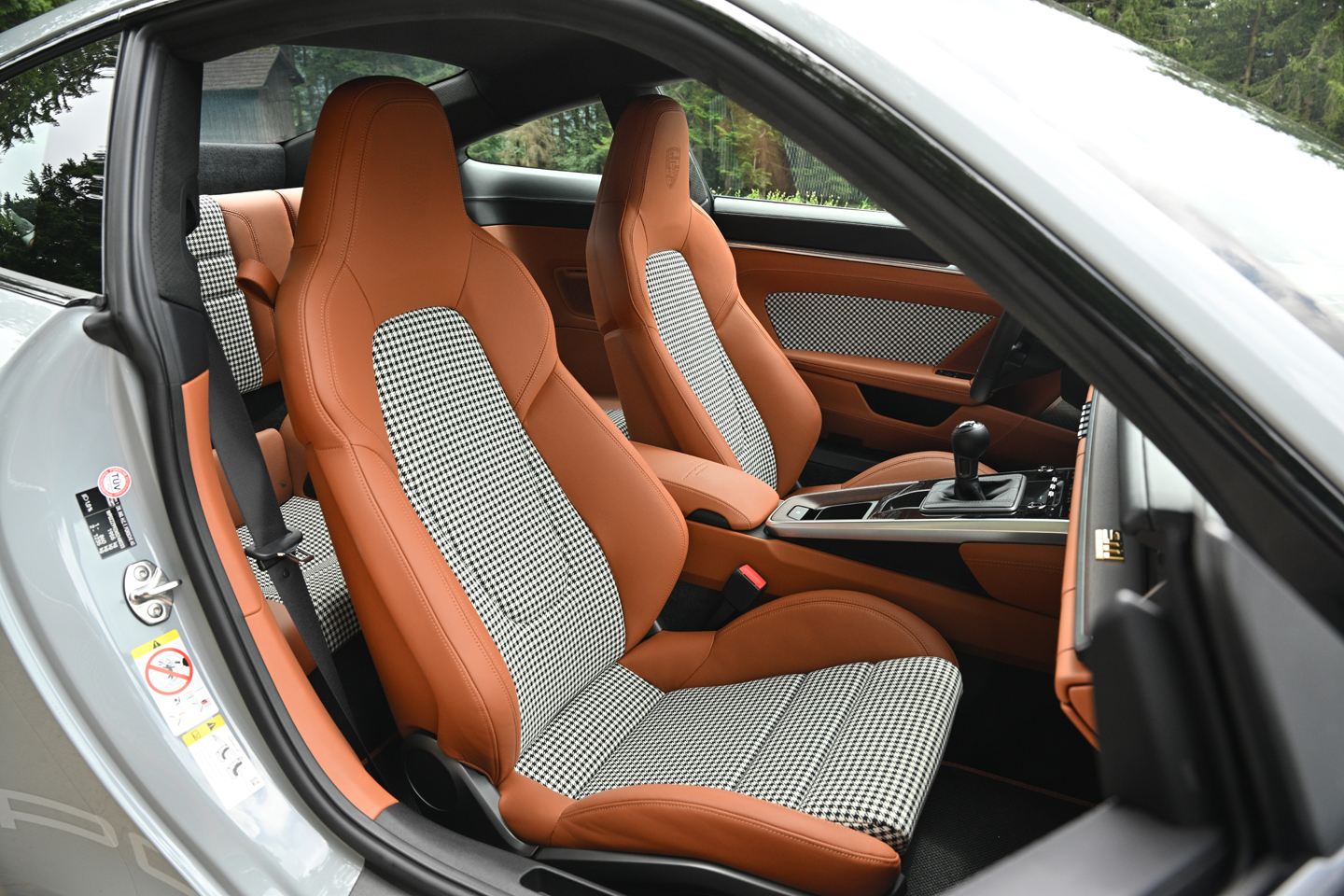
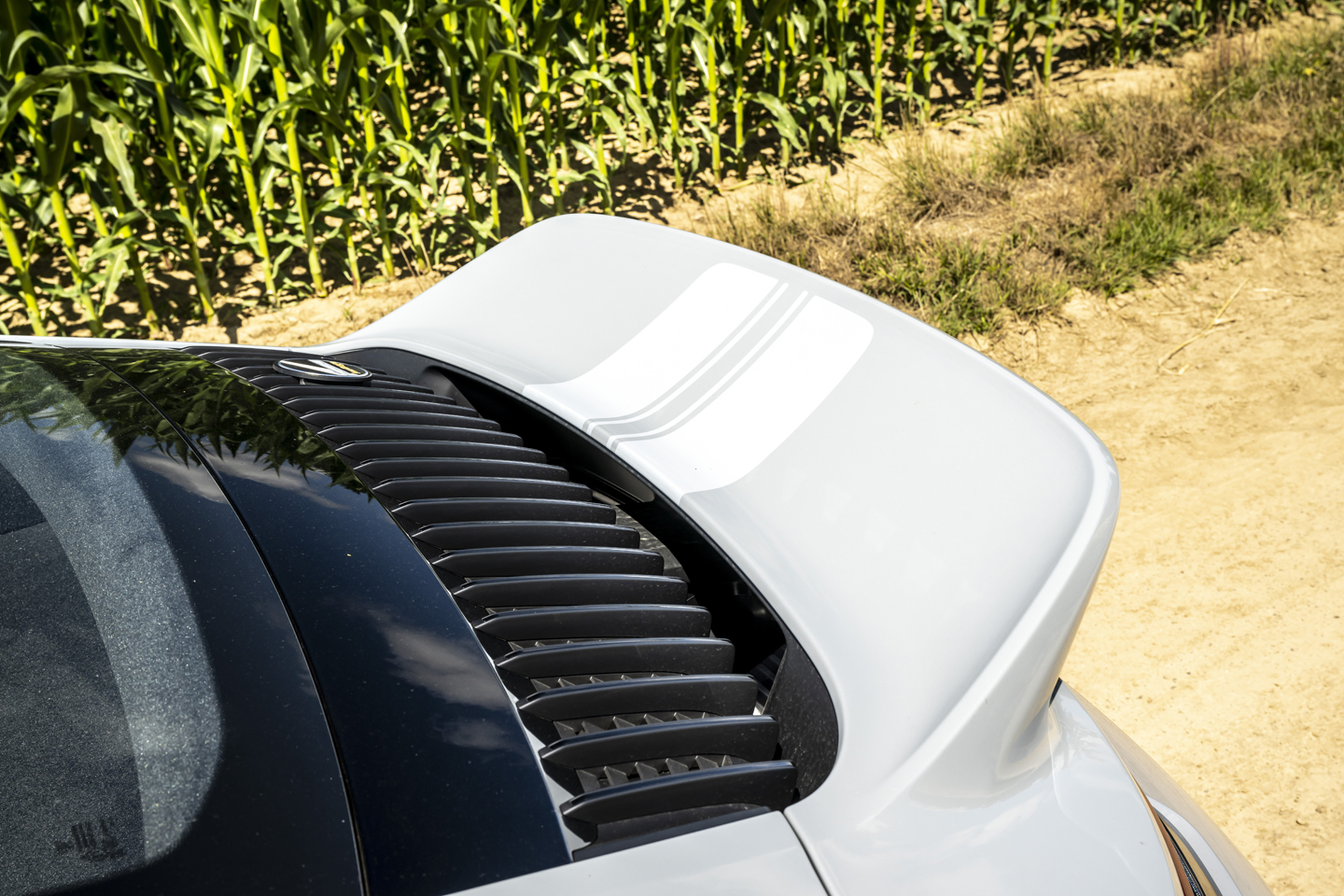
By now we’re deep into the countryside. If you like your scenery green, then this is the place. I know this sounds moronic, but everything here is just greener. The purest green. Like Austria and Switzerland, the grass and the trees are so vividly verdant it’s like they’re fake – as if you’re staring at a full-size Hornby train set where the landscape is coloured by a paintbrush rather than the hand of God. My date with gateau is waiting for me at a place called Renchtalhütte. It’s a little chalet a high up in the hills, apparently, and I’m savouring the climb.
Just like points mean prizes, hills mean hairpins, and a good chance to explore the traction. I expect it to feel quite loose under power, bearing in mind the Turbo’s toehold has been halved. Yet it isn’t. As you power out of tight turns, the Sport Classic sticks with the classic 911 trait: digging deep into the Tarmac, the weight transfer squelching those already fat rear contact patches into the surface’s pores. And the weather is onside, too. The sun is shining so the surface is hot, making the P Zeros stickier still. It feels so secure that, at the next opportunity, I push my luck and the accelerator harder. Yep, it will oversteer on demand. Of course it will. It has 443lb ft of torque available. Still, you need to be pretty brutish on a day like today. I’ve no doubt that on a colder, wetter day, the Sport Classic will demand a much more sympathetic approach, but right now I’m not feeling endangered by it in the least. I’m just out in the hinterland having fun in a well-adjusted sports car.
Is it a good grand tourer? No, it’s a great one. That’s probably the biggest takeaway from my drive, actually. Stuttgart to the Black Forest isn’t really that far. We’re deliberately not going as the crow flies, but even so ‘destination gateau’ is just over two hours and 100 miles away. But those aren’t my only miles in the Sport Classic. I left at 9am and I’m not due back until dinner at 7pm tonight. Plus, we have another half day with the car the next day, to do all the photography. So, by the end of our time together, I’ve covered some miles. If you have one on order, I urge you: don’t lock it away and watch its value rise.
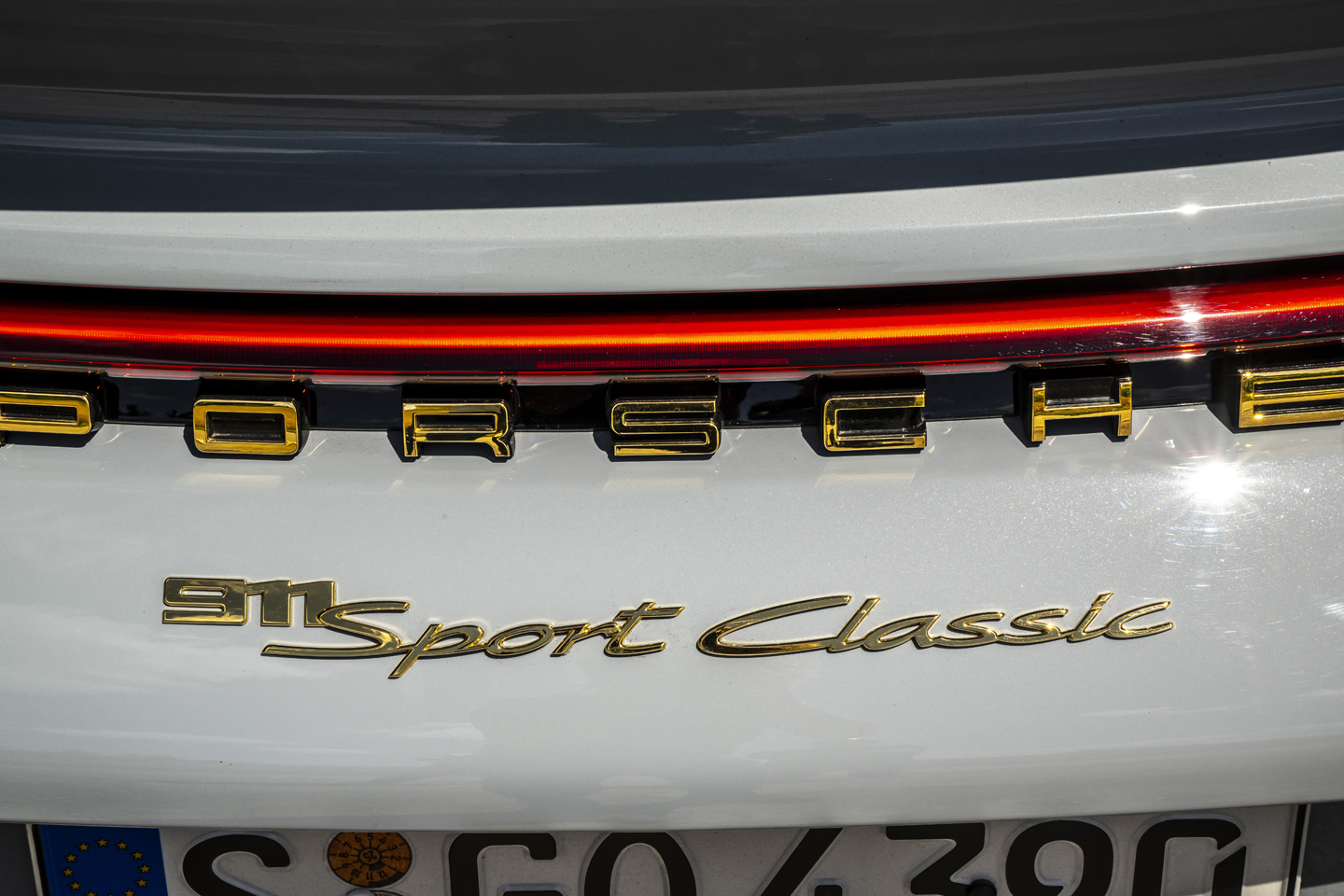

Drive the thing, please. The Sport Classic is the kind of car to take from Stuttgart to Saint Tropez, via Salisbury, and you’ll arrive feeling fresh. For a start the ride is so amenable. Granted, Germany isn’t peppered with bumps like the UK is, but even so. I can tell you that this car will ride relatively well over here, too. Even if you choose to switch the suspension to Sport, to keep the body in check – and there are times when it needs checking over a series of ups and downs – you discover that the bandwidth between Comfort and Sport is not a gulf. It feels better locked down, but not noticeably firmer.
I’d like to give a special mention to the brakes. They’re superb. Carbon ceramics come as standard on the Sport Classic, and their herculean stopping power isn’t at the expense of finesse or feel. It’s a joy to drive a car this powerful and have complete trust the anchors when the next bend is approaching like a fast-forwarded film.
Finally, the Black Forest gateau – which was as you’d expect it to be from the place where they hail: rich, indulgent and something to savour. A bit like the Sport Classic, you might say. After all, it’s made by the people who know how to make a rear-engine, turbocharged sports car, with a manual gearbox to add the cherry-on-top flavour. It’s great. True, a three-pedal Carrera GTS manual will get you 98 per cent of the way there, so in objective terms you’d be mad to spend £215,000 on a Sport Classic. But, in objective terms, I didn’t need to drive to the Black Forest just to have a slice of cake. I’m glad I did, though. It was something special. And you’ll either get that, or you won’t.
Specification | Porsche 911 Sport Classic (992)
Engine: 3,745cc, flat-six, twin-turbo
Transmission: 7-speed manual, rear-wheel drive
Power (hp): 550 @ 6,750rpm
Torque (lb ft): 443 @ 2,000-6,000rpm
0-62mph: 4.1 seconds
Top speed: 196mph
Weight: 1,570kg (DIN)
MPG: 22.4 (WLTP)
CO2: 285g/km (WLTP)
Price: £214,200






More Stories
3 Pieces of Equipment Needed for Badminton
The Advantages of Online Sports Betting
A Sport For Every Season With Satellite TV Packages